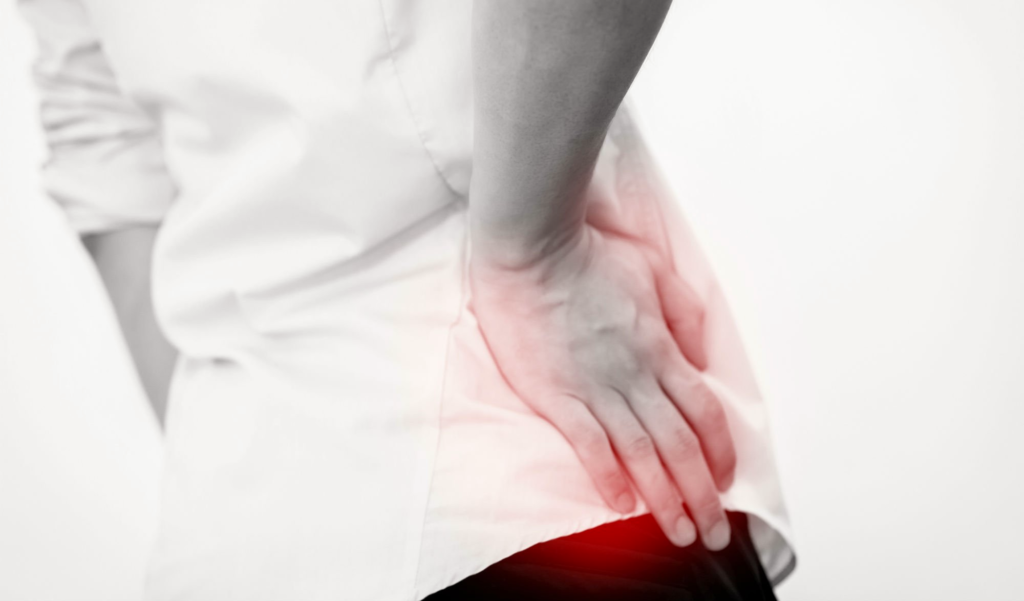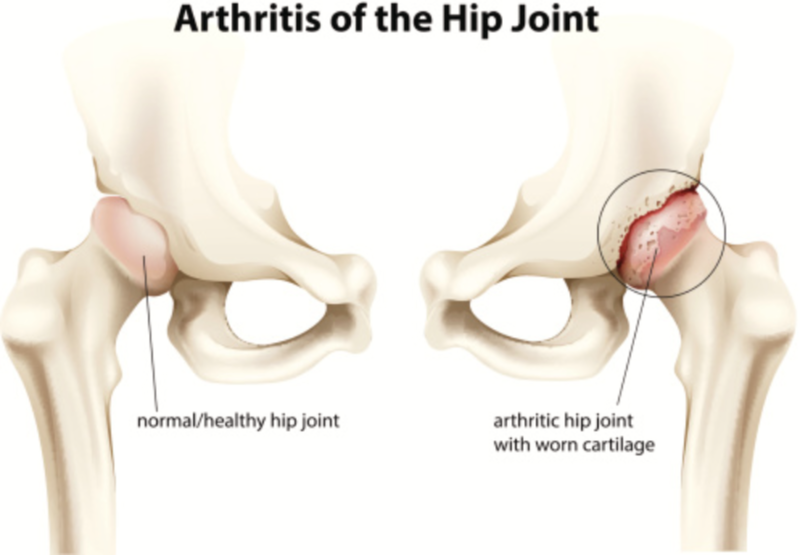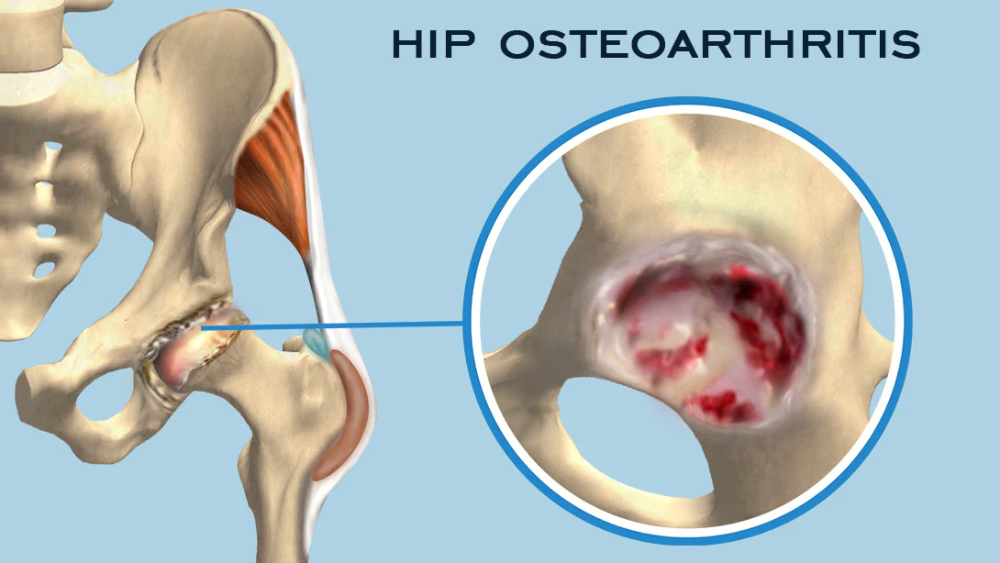Causes of hip pain, hip pain is a common condition that affects many people at some point in their lives. This type of pain can range from a dull ache to a sharp, stabbing sensation and can be located in various areas of the hip joint. In severe cases, hip pain can also radiate down the leg, causing significant discomfort and even affecting mobility.

The hip joint is a ball-and-socket joint that is responsible for supporting the weight of the body and allowing for a wide range of movement, including walking, running, and jumping. Because of its important role, it’s essential to understand the various causes of hip pain and to seek proper treatment to alleviate symptoms and prevent future complications.
In this article, we will explore the most common causes of hip pain and discuss the available treatments for each.
Common Causes of Hip Pain
Hip pain is a common ailment that can affect anyone at any age. There are many causes of hip pain, and the most common ones include arthritis, a hernia, and a fracture. Other causes of hip pain may include a muscle injury, a tumor, or a condition called osteoarthritis. Hip pain can be extremely debilitating and can make it difficult to do everyday activities. If you are experiencing hip pain, it is important to see a doctor to determine the cause and to develop a treatment plan.
Arthritis
Arthritis is a condition that causes hip pain and involves inflammation of the joints, leading to pain and stiffness. There are several types of arthritis, including osteoarthritis and rheumatoid arthritis, which can both affect the hip joint. Osteoarthritis is a degenerative condition that results from wear and tears on the joint, while rheumatoid arthritis is an autoimmune disorder that causes inflammation in the joints.

Symptoms of arthritis in the hip include pain and stiffness, especially after periods of inactivity or at the end of the day. In severe cases, joint deformity and limited mobility can also occur.
Osteoarthritis
Osteoarthritis is a degenerative disease of the joints that most often affects the hands, hips, and spine. The disease is caused by the wear and tear of the cartilage in the joint. The cartilage is a type of tissue that cushions the bones in the joint. Over time, the cartilage becomes thin and brittle. This makes the joint less able to move smoothly and can cause pain.

There are many symptoms of osteoarthritis, but the most common are pain, stiffness, and difficulty moving. Other symptoms may include a decrease in the range of motion in joints, a loss of range of motion in the spine, a decrease in the number of cartilage cells in the joint, and a decrease in the production of cartilage.
Rheumatoid arthritis
Rheumatoid arthritis is a chronic autoimmune disease that causes inflammation of the joints. The disease can affect any joint but is most commonly seen in the fingers, wrists, knuckles, and ankles. Symptoms can include joint pain, stiffness, and swelling. Rheumatoid arthritis can be difficult to diagnose, and there is no cure. Treatment focuses on relieving symptoms and managing the disease.
There are many symptoms of Rheumatoid arthritis, but they can vary from person to person. Some common symptoms include:
- Joint pain
- Swelling and stiffness in the joints
- Fatigue
- Redness and swelling around the joints
- Loss of function in the joints
If you are experiencing any of these symptoms, it is important to see a doctor to determine if you have Rheumatoid arthritis. There are many different treatments available to help relieve the symptoms of Rheumatoid arthritis, and a doctor can help you find the best one for you.
Bursitis
Bursitis is a condition that involves inflammation of the fluid-filled sacs, called bursae, that cushion the hip joint. Bursitis can be caused by a variety of factors, including injury, overuse, and underlying conditions such as rheumatoid arthritis.
Symptoms of bursitis include pain, swelling, tenderness, and a clicking or snapping sound in the hip joint. The pain is typically worse when the hip is moved and can be accompanied by swelling and tenderness.
Fibromyalgia
Fibromyalgia is a disorder that is characterized by widespread pain in the muscles and joints, as well as fatigue. Causes of hip pain, the pain is often accompanied by a sense of stiffness, and it can be very difficult to move around. Fibromyalgia is thought to be caused by a combination of genetic and environmental factors. There is currently no cure for fibromyalgia, but there are treatments that can help relieve the symptoms. Treatment options include medications, physical therapy, and surgery.
Fibromyalgia is a disorder that affects the muscles, tendons, and ligaments. The pain is usually widespread, and it can be severe. People with fibromyalgia often have a difficult time sleeping, and they may have problems with their moods and energy levels.
Tendinitis
Tendinitis is a condition characterized by inflammation of the tendons, the strong fibrous cords that connect muscles to bones. It can affect the hip joint, resulting in pain and discomfort in the hip and thigh area. Treatment may involve rest, physical therapy, and anti-inflammatory medications. If left untreated, tendinitis can lead to severe damage to the affected tendon and even joint instability.
Common causes of tendinitis in the hip include overuse, injury, and underlying conditions such as arthritis. Symptoms of tendinitis typically include pain, tenderness, and stiffness in the affected area along with a decreased range of motion, swelling, and warmth in the affected area.
Hip Fracture
A hip fracture is a serious and potentially life-threatening injury that occurs when the bone in the hip joint breaks. This type of injury is most commonly seen in older adults and is usually caused by a fall. It is important to seek medical attention immediately after a hip fracture, as it can lead to long-term complications if not treated properly.
Symptoms of a hip fracture typically include sudden, intense pain in the hip area, difficulty walking or standing on the affected leg, swelling and bruising around the hip joint, an inability to move the leg normally, and an audible or palpable clicking or snapping sensation in the hip area.
Snapping Hip Syndrome
A snapping hip syndrome is a condition that causes a snapping or popping sensation in the hip joint, accompanied by pain and discomfort. This condition is caused by the tendons or muscles in the hip joint rubbing against the bones, leading to inflammation and pain.
Symptoms of snapping hip syndrome may include pain and tenderness in the hip, a snapping or popping sensation when the hip is moved, difficulty with certain hip movements such as walking or running, and a feeling of instability or weakness in the hip joint.
Diagnosis for Hip Pain
Hip pain can be a sign of a number of conditions, but it’s usually a sign of something wrong with the hip joint. Your doctor will want to do a physical exam and check for other symptoms to determine the cause of your hip pain.
They may also do a diagnostic test to see if there’s a fracture or other problem with the hip. Treatment depends on the cause of the hip pain, but often includes rest, ice, and pain medication.
Physical examination
Physical examination for hip pain should include a complete medical history, a physical examination, and a review of systems. The physical examination should include a careful assessment of the hip region for tenderness, swelling, deformity, and redness.
The examination of the hip region should also include an assessment of the range of motion and strength of the hip flexors and extensors.
If the person has hip pain, the doctor may order an x-ray to rule out any fractures or other injuries. If the person has hip pain and is also having difficulty walking, the doctor may order an MRI to assess the extent of the hip injury.
If the person has hip pain and is also having difficulty climbing stairs, the doctor may order an electrocardiogram to assess the severity of the hip injury.
Imaging tests for hip pain
There are a few imaging tests that can be used to evaluate hip pain. These tests can help to identify the source of the pain and may provide relief. A CT scan is the most common imaging test used to evaluate hip pain. CT scans use X-rays to create images of the body. This test can help to identify any abnormalities in the hip, including bone fractures or tumors.
An MRI scan is also a common imaging test used to evaluate hip pain. MRI scans use powerful magnets to create images of the body. This test can help to identify any abnormalities in the hip, including bone fractures or tumors. A CT scan and an MRI scan are both considered to be very accurate tests for diagnosing hip pain.
Prevention Of Getting Hip Pain
There are a few things that you can do to help prevent hip pain. First, make sure that you are getting enough exercise. This can be done by walking, biking, swimming, or any other form of aerobic exercise. Second, make sure that you are using the right type of footwear. Avoid wearing high heels, tight shoes, or boots that are too tight. Finally, make sure that you are getting regular checkups to make sure that your hip is healthy.
Exercise to Avoid Getting Hip Pain
One way to avoid hip pain is to exercise regularly. Hip pain can be caused by a variety of factors, including obesity, genetics, and age. If you are overweight or obese, you are more likely to experience hip pain. Exercise can help to reduce your risk of hip pain. A regular exercise routine can also help to improve your overall health.
Avoiding activities that strain the hip
Hip pain can be a serious issue and can be caused by a number of different factors. One of the most common causes of hip pain is when the hip is overused or strained. To prevent hip pain, it is important to avoid activities that strain the hip. Some common activities that can strain the hip include running, jumping, and walking. It is also important to maintain good posture and avoid sitting for long periods of time. If hip pain is severe, it may be necessary to see a doctor.
Treating Hip Pain
The treatment for hip pain varies depending on the underlying cause. In most cases, a combination of self-care measures, such as rest, lifestyle modifications, and physical therapy, as well as medical treatment, like medications, injections, and surgeries, can be effective in alleviating symptoms and restoring mobility.
Self-care measure for hip pain
There are many self-care measures that can be taken to help alleviate hip pain. Some of the most common include:
- Taking regular breaks throughout the day to move around and stretch
- Eating a healthy, balanced diet
- Exercising regularly
- Taking pain relief medication as prescribed by a doctor
- Using a foam roller to loosen up the hip muscles
- Taking hot baths or showers
- Practicing stress relaxation techniques
It is important to remember that self-care is not a one-size-fits-all approach and that the best way to find what works best for you is to experiment and find what helps you feel better. There are many resources available to help you find the information and tools you need to live a more comfortable and pain-free life.
Non-surgical treatments for hip pain
There are a variety of non-surgical treatments for hip pain that can be tried, including:
Physical therapy: This can help to improve the range of motion and flexibility in the hip, which can reduce hip pain.
Heat therapy: This can help to reduce inflammation and pain in the hip.
Icing: This can help to reduce inflammation and pain in the hip.
Acupuncture: This can help to improve circulation and reduce inflammation in the hip.
Surgical treatments for hip pain
There are many surgical treatments for hip pain. The most common is hip replacement, which is surgery to replace a damaged or worn hip joint. Other surgical treatments include arthroscopic surgery, which is a surgery using a small, camera-equipped tool to view and repair the joint; and microdiscectomy, which is a surgery to remove a small piece of the hip joint.
Conclusion
In conclusion, hip pain can have a wide array of underlying causes, from injury to illness. It is important to understand the potential causes and seek medical help if the pain persists or worsens. By properly understanding the causes of hip pain, a person can effectively manage and reduce discomfort.
With the help of a healthcare provider, an individual can take the necessary steps to find relief from hip pain and restore balance to their life. If you find these blogs helpful, please share this with your loved ones and friends. You are also welcome to visit our other related blog for more tips and recommendations.


